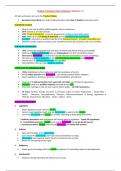Summary
Summary CIPP/E Revision Notes
- Course
- Institution
A complete summary of all the information needed for the 2023 CIPP/E exam. Compiled from the European Data Protection Law & Practice textbook, EDPB guidelines and background reading. Used to obtain an overall score across all three sections of 98.7%.
[Show more]



